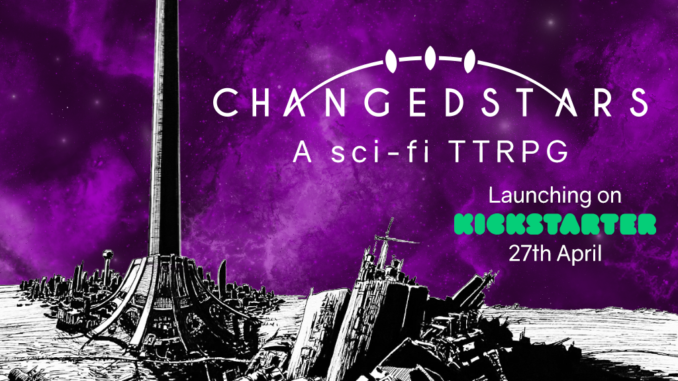
System designer, Leland Andercheck, and setting creator and artist, Patrice Gehman, have a Kickstarter for their scifi RPG, ChangedStars. In this article, the two talk about the project, the system, and what’s next for them.
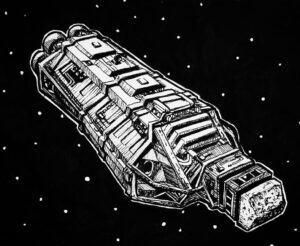 EGG EMBRY (EGG): I appreciate you talking with me about this project. What is ChangedStars?
EGG EMBRY (EGG): I appreciate you talking with me about this project. What is ChangedStars?
PATRICE GEHMAN (PATRICE): ChangedStars is a snarky yet hopeful scifi TTRPG set in a future where humanity is finally embracing the diverse galaxy around them, finding their place within it, and surviving the hardships of an interstellar existence together. It’s filled to the brim with lore and culture to bring the sentient species of the galaxy to life. ChangedStars presents a post-patriarchal communist near-utopian setting that still offers adventure and danger to overcome in the name of the greater good.
LELAND ANDERCHECK (LELAND): As Pat says, ChangedStars is exploring a different sort of science fiction world. We’re making a game that cuts the balance between a hopeful future and one with lots of complications and danger to handle with adventures to go on. I think we’ve done a damn good job, and this roleplaying game and our (many) actual plays are just the beginning of the total media I see ChangedStars growing to encompass one day. For this Kickstarter though we’re keeping our heads down and just getting the core book out, printed, and in hands/on shelves across the world.
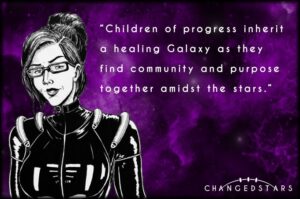 EGG: When and where does this RPG’s setting take place?
EGG: When and where does this RPG’s setting take place?
PATRICE: The setting takes place roughly 500 years in our future. Humanity charges head first into space perpetuating much of the same exploitative behaviors they never evolved past on earth. This eventually culminates in the formation of the “Empire of Man,” a regressive state exemplifying all of humanity’s worst impulses. This imperialist force attempts to invade the Murai, a hive-based insectoid species, but fails thanks to their allies, the Thren Federation, and the human empire falls after a prolonged interstellar war. The Murai, Thren, and rebel humans spend the next fifty years rebuilding humanity; decolonizing stolen land, undoing years of military indoctrination, and toppling the oppressive hierarchies of the empire, forming the Artemisian commune. The Year is now 50 A.O. (After Origin). It’s been 50 years since the Foundation of the Trinity: The first Interspecies Union in Orion’s Arm, between the Artemisian Commune, the Murai Council of Queens, and the Thren Federation.
LELAND: Pat really covered this, all I’ll say is that the game predominantly centers on the Frontier where some of the worst growing pains and logistical issues are still impacting daily life.
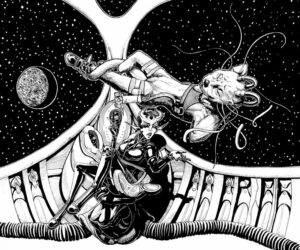 EGG: You’ve stated this project has “feminist and LGBTQ+ leanings”, which feels right in every game and in life, but especially so in the future in which humanity is embracing its better self. Is that a fair assessment of the setting, a brighter, more positive universe?
EGG: You’ve stated this project has “feminist and LGBTQ+ leanings”, which feels right in every game and in life, but especially so in the future in which humanity is embracing its better self. Is that a fair assessment of the setting, a brighter, more positive universe?
PATRICE: I came at the setting with hardship-tempered optimism. Humanity has endured growing pains, and it hasn’t arrived in this brighter future on its own… But it belongs here. As a queer woman, I’ve seen a lot of the cruelty humanity is capable of… but also our compassion. ChangedStars is a setting that encourages the later while acknowledging the former. It’s a setting that holds no punches in denouncing the very real potential for humans to slide into regressive thinking, but it’s also a setting that believes in humanity’s ability to make the right choice and evolve. The Trinity is a society that I would like to live in, but one that I will not live to see. It’s a beacon of hope in a shelf filled with dystopian scifi settings. It’s there for your players to find safe-harbor after overcoming whatever trials they endure in their interstellar adventures.
LELAND: We’re definitely shooting for something that does not need to be homebrewed to embrace a plethora of identities and people. Much adieu is made about modifying triple-A productions to be more inclusive, but I think something that was envisioned that way from jump will always have an inherently better foundation to tell stories with a certain lean.
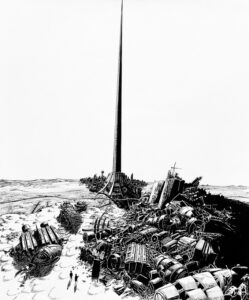 EGG: When we discussed this you called it a “hard-er scifi RPG”. Let me ask this, what will make this a “hard-er scifi” RPG?
EGG: When we discussed this you called it a “hard-er scifi RPG”. Let me ask this, what will make this a “hard-er scifi” RPG?
PATRICE: So “hard” in this case means we try to rationalize the technology in play. We delve into the hypothetical physics of our biggest lie (FTL travel through wormholes, and associated artificial gravity generation) but everything aside from that is fairly grounded in reality. Most space vessels or structures create gravity through linear acceleration or centripetal force, if at all. There is no faster than light communication. Spaceships aren’t aerodynamic unless they’re shuttles intended for atmospheric travel. The Alien species have realistic-yet-alien biologies (I’m a biologist myself). In creating the setting I concerned myself not only with making it aesthetically cool, but also with grounding the setting in the real world.
LELAND: The “hard-er” term is my addition while trying to grapple with how to convey our setting in the fewest words possible. I’m neither a biologist nor a science guy in general, because while I find space a fascinating setting I tend to lean more sci-fan and soft scifi. It has been an exciting writing challenge to colour inside these lines, and I think we highlight the benefits—more mundane stories like micrometer asteroids can become gripping life-or-death stories. I think what really makes it “hard-er” scifi is that you can tell a science thriller plot like ARMAGEDDON and nobody says “why didn’t a space wizard just fix this?” This struggle with the uncaring facts of the universe is not mitigated by magic or psychic abilities. If an asteroid’s gonna hit someone has to go out and stop it.
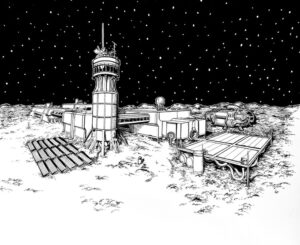 EGG: “Hard-er” makes me think there will be some creative license with the setting. Is that accurate? Is there something fantastic in your RPG?
EGG: “Hard-er” makes me think there will be some creative license with the setting. Is that accurate? Is there something fantastic in your RPG?
PATRICE: Apart from the broad scope of the setting taking place over thousands of stars that can be traversed in a matter of years, and the fact that there are sentient, mostly-relatable species with whom humanity has interacted? The existence of the Sunderers, the setting’s “precursors,” is a tad fantastic. They shot through Orion’s Arm like a bullet milllennia ago literally seeding the stars for destruction to fuel the same gravity and FTL technology that the other sentient species of the Arm now rely on. Who knows what happened to them but assumedly they were headed to the core. ChangedStars’s name is twofold. First it refers to humanity’s anticipated destiny of dominating the stars being altered into a more positive trajectory, but secondarily it refers to the fact that a lot of the stars in the universe were LITERALLY changed before we even crawled out of the sea as leggy-lungfish.
LELAND: Let me put it this way—a friend of ours ran a ChangedStars game with force fields and tractor beams. Our setting has neither, officially, yet the story never once lost the spirit and tone of the game. Pat has remarked it was her favoured campaign of ChangedStars to date recently. When a gamebook reaches the DreamWeaver’s hands, when they enter the shared sacred space of play with their table, our control ends and their experience begins. We give them the hard-er basis to launch from. Anything more fantastical they choose to put in is only made all the more so by juxtaposing it with an otherwise more firmly scientific world.
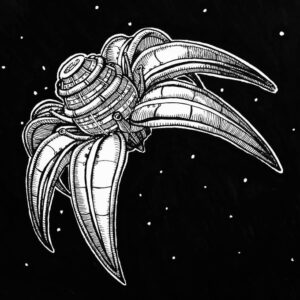 EGG: Mechanically, how does this system work?
EGG: Mechanically, how does this system work?
LELAND: ChangedStars is driven by a d6 dual dicepool system. One pool reflects your character’s relevant stat and skill, and the other a rising push-your-luck Edge system that risks sending you spiraling out of control as the pressure gets to you If you’ve played TTRPGs like Shadowrun, World of Darkness, or Alien RPG or board games like Arkham Horror, you’ll already be familiar with the roll for success concept. In most instances you’re only trying to score a single 6. We did this to avoid the issue some dice pool games run into where they need more than about a fistful of dice to make a standard test, or tallying up discrete numbers makes every test take longer. Everything else flows from that concept and we try to keep things simple enough to be universally understood; there are four core stats with three governed skills apiece, and individual talents obtained from a character’s species or character generation\progression alter some of how they are played or give situational bonuses.
PATRICE: The game is designed to put you in the shoes of an “Average Jane” in most cases, and pit you against the challenges of interstellar life. You use your stat and skill to determine how many dice you roll on a given challenge and can stretch to get edge dice, which can backfire on you. If you build enough edge you can cash it in for an “Edge Break” which is an extraordinary ability you access through your archetype or by choice in an ala carte character creation process. Edge Breaks are those marvelous moments when your character gets to declare their prowess to the uncaring void of space and change their fate, either auto-succeeding, or unlocking more dice, or a variety of other amazing abilities. This is all part of creating a versatile system that lets you tell any kind of story you wish to in the setting while emphasizing the stresses of life among the stars and the extraordinary lengths to which an average person can go to accomplish their goals.
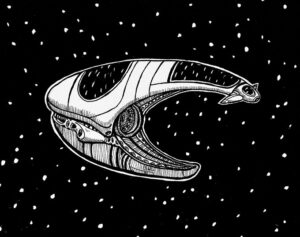 EGG: You have a quickstart for this, what does it offer compared to the core product?
EGG: You have a quickstart for this, what does it offer compared to the core product?
LELAND: The Quickstart provides, for free, the primary rules and a tasting platter of lore. It gives enough to run and contextualize some common types of ChangedStars adventures without being laden with the full kit of every item and option the full game has. This includes a short three-to-five scene scenario to acclimate both players and DreamWeaver to the system and world and can be set almost anywhere in the universe that has a moon in it. It includes pregenerated characters, but not character generation rules. Its item list is not exhaustive and it does not include vehicle or spaceship rules, nor rules on several particular subsystems or particular situations. For example it tells you what Hazards are and how to run them, but does not cover our particular implementation of Radiation as a Hazard. If it comes up in an adventure run off the Quickstart, the DreamWeaver’s going to make a judgment call on the specifics—but like a save in 5e or an OSR game, they’ve got a mechanical framework within which to do it, and won’t need to invent mechanics on the spot. They just need to gauge how deadly they think this radiation is and go from there.
The idea is to give you the core of the system, show you what it looks like in practice, and fill you in on the tip of the iceberg world wise. It’s the sort of thing we see getting used well after release for people trying to get a sense for the world from a totally free download. But for a full campaign, you’ll really be wanting the main book. We’ll be including an adventure alongside various vehicles like spaceships and hoverbikes, many more items like weapons and armour but also tools and pharmaceuticals. The core will contain a DreamWeaver’s section on running the game, and of course a robust yet simple character generation system.
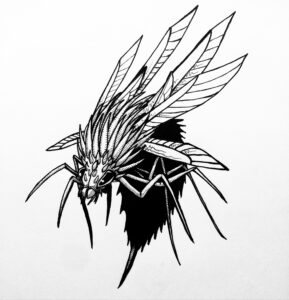 EGG: Let’s swing over to the art. Patrice, you’re creating the look of the universe, which is a tall order. What inspires your art for this project? What medium(s) are you working in?
EGG: Let’s swing over to the art. Patrice, you’re creating the look of the universe, which is a tall order. What inspires your art for this project? What medium(s) are you working in?
PATRICE: Oh wow. This is a huge question. So, I’ll start by saying I’m the illustrator and predominantly a traditional medium artist. The cover is an oil painting I spent weeks working on… you can ask my friends. I have shed tears over this piece. The interior of the book will be full of my black and white inked work, harkening back to old school scifi TTRPG books like Rifts and Traveller. This is kinda a result of playing to my own personal skills, but also an intentional nod to the feminist scifi roots of ChangedStars which is a genre that emerged in the 70s but didn’t get the loving treatment in scifi TTRPGs of the era I feel it was due.
Mediums aside, the aesthetic of the verse is intrinsically connected to the metaplot. The stark contrast between the blocky and phallic Human Empire spaceships and the organic and floral Thren spaceships is a visual that tells a lot of the story without my having to spell it out. Form and function are key to the designs of vessels, architecture and garb alike in the ChangedStars universe. I spent a great deal of time designing ships, costumes, flora and fauna that makes sense and adds to the realism of the universe while conveying just the right amount of whimsy and heart.
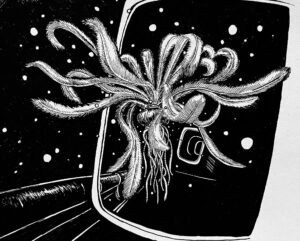
I can’t finish talking about the art without adding a brief section about my inspirations, because art is kinda a dialogue between yourself and the world. It’s deeply personal but also decidedly external. No artist is unaffected by those who came before them and their peers. I’ve taken so much inspiration over the years from some truly spectacular artists, and to name them all would be difficult. I’ll start off with some silly ones: Thank you, Lego, for inspiring me to draw cool looking spaceships. That out of the way, the Thren are particularly influenced by some noteworthy artists. The design is heavily influenced by the artwork of Incase, while their vessels and architecture are inspired by HR Giger and Georgia O’Keefe, and my own stepfather and his peers. I came up with and illustrated ChangedStars in the Studio I inherited from my stepfather Larry Mckim. His final work before he passed two years ago was a groundbreaking series of floral pieces I have over my shoulders at this very instant. If he were still with me I hope he’d be proud of the work I’ve done here.
EGG: Beyond ChangedStars, what else are you working on?
LELAND: Right now our main focus is ChangedStars and ChangedStars adjacent content, but normally we run two other tabletop RPG streams on a recurring basis and some other impromptus here and there. They are High Road, a D&D 5e game in a setting informed by several real world and fantastical cultures known as Rosenkrieg, and Uranium Fever, a Fallout game we run with my first game the Akroydiesel Age RPG as its mechanical underpinning. We’re always looking to tell new, exciting stories on twitch.tv/dieselshot and as we continue through the campaign we’ll be streaming there five nights a week to share what ChangedStars is all about with copious Actual Play content.
PATRICE: I’m working with the Dieselshot team to put out as much content as we possibly can. I’m an artist and I want to share that with the world. Over the summer in addition to finishing up ChangedStars and creating more content for the ‘verse in the form of adventures and related content and the odd job here and there, I’ll be finishing the art for my collaborative partner Worldbuilder101’s Descendants of Darkness Zine that was super successful. I also do pixelart tilesets for Roll20, one of which has a lot of ChangedStars content shoehorned into it already called MegacorpsMarinesAndMonsters.
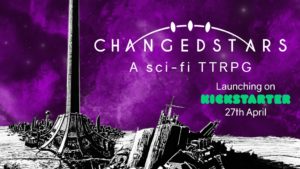 EGG: Thanks for walking with me. Where can fans learn more about this project?
EGG: Thanks for walking with me. Where can fans learn more about this project?
LELAND: Thanks for having us Egg! [The Kickstarter, the ChangedStars website], @StarsChanged on Twitter, and our Discord are your primary stops for all things ChangedStars! We’re always happy to chat with people interested in the wonderful world we’re creating together.
PATRICE: Thank you so much for having us!
ChangedStars – A Sci-fi TTRPG from DieselShot
“In an interplanetary future, the Trinity has emerged from the ashes of a long-dead empire to bring hope.”
Egg Embry participates in the OneBookShelf Affiliate Program and is an Amazon Associate. These programs provide advertising fees by linking to DriveThruRPG and Amazon.
Latest posts by Egg Embry (see all)
- New Gamemaster Month 2023 - January 20, 2023
